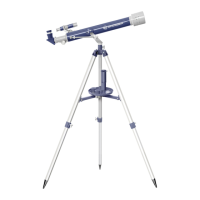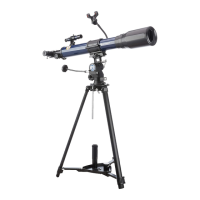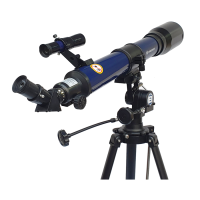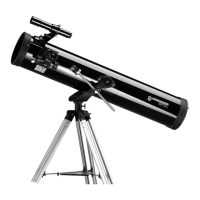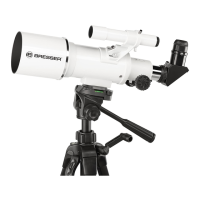2. Troubleshooting:
Mistakes: Help:
No picture Remove dust protection cap and
sunbathe-shield from the objective
opening.
Blurred picture Adjust focus using focus ring
No focus possible
Wait for temperature to balance out
Bad picture Never observe through a glass
surface
Viewing object visible Adjust finder (See Part I:
in the finder, but not 8. Construction)
through the telescope
Heaviness in the flexible Telescope and counter
handles on the axis weight not balanced
over the shaft
Despite using star The star diagonal prism
diagonal prism should be vertical in
the picture is the eyepiece connection
“crooked”
DISPOSAL
Dispose of the packaging materials properly,
according to their type (paper, cardboard, etc).
Contact your local waste disposal service or
environmental authority for information on the
proper disposal.
Please take the current legal regulations into
account when disposing of your device. You
can get more information on the proper disposal
from your local waste disposal service or envi-
ronmental authority.
NOTES on cleaning
Clean the lenses (eyepiece and/or lens) with a soft and lint-free
cloth only (e.g. microfibre). Do not apply excess pressure to the
cloth so as to avoid scratching the lenses.
To remove more stubborn dirt, moisten the cleaning cloth with an
eyeglass-cleaning solution and wipe the lenses gently.
Protect the device from dust and moisture! After use - in particu-
lar in situations of high humidity - let the device acclimatize for a
short period of time, so that the residual moisture can dissipate.
Remove the dust cover and store it in the included bag.
Part III – Appendix
1. Possible observation targets
In the following, we like to present to you a choice of very
interesting and easy-to-find celestial objects. On the depending
pictures at the end of the manual you will see how they will
appear in the eyepiece of your telescope:
The moon (Fig. 31)
The moon is the only natural satellite of the earth.
Diameter: 3,476 km
Distance: 384,000 km (average)
The moon is well-known since thousands of years. He is the
second-brightest celestial object after the sun. Because the
moon circles around the earth, he changes periodically its
inclination to the sun; therefore we see changing phases. The
time for one complete lunation is 29.5 days (709 hours).
Constellation Orion: The great Orion nebula / M 42 (Fig. 32)
Right Ascension: 05h 33’ (hours : minutes)
Declination: -05° 25’ (Degrees : minutes)
Though it is 1,600 light years away, the Orion nebula (M 42) is
the brightest nebula object at the sky – visible even with naked
eyes and a worthwhile object for telescopes of all kinds and
sizes. It consists of a gigantic cloud of hydrogen gas with a
diameter of hundreds of light years, taking a field on the sky of
10°.
Constellation Lyra: The Ring Nebula / M 57 (Fig. 33)
Right Ascension: 18h 52’
Declination: +32° 58’
Distance: 4,100 light years
The famous Ring Nebula is often called the prototype of
planetary nebulae; he belongs to the northern hemisphere
summer sky’s pieces of splendour. Recent investigations have
shown that he is a ring of light-emitting matter that surrounds its
central star (only visible in bigger telescopes). If one could look
onto its top, he would see a structure like the Dumbbell Nebular
/ M 27
Constellation Vulpecula (little fox):
The Dumbbell Nebula / M 27 (Fig. 34)
Right Ascension: 19h 59’
Declination: +22° 43’
Distance: 1,250 light years
The Dumbbell Nebula / M 27 was the first planetary nebula ever
found. On July 12th, 1764, Charles Messier discovered this new
and fascinating class of objects. We can see it directly from its
equatorial pane. If it could be viewed from top, we would appear
like the Ring Nebula / M 57. This Object can even be viewed at
average weather conditions at low magnifications.
